Beautiful Plants For Your Interior
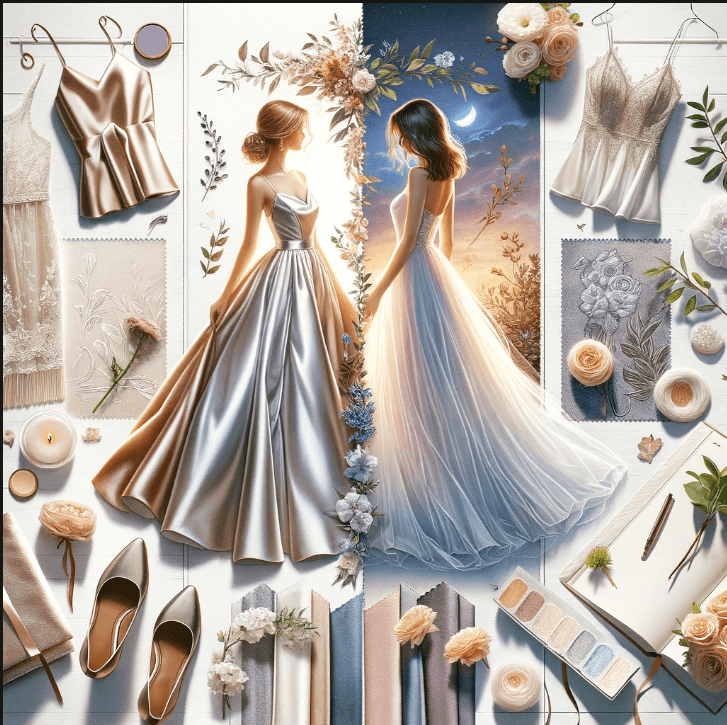
Table of Contents
Introduction
When planning a wedding, every detail counts to create the perfect ambiance for your special day. Among these details, the choice of bridesmaid dresses stands out as a crucial element that complements the bridal look and enhances the overall aesthetic of the ceremony. A common dilemma faced by many brides is the choice of fabric for these dresses, with satin and chiffon being two popular contenders. This decision not only impacts the visual harmony of the wedding party but also the comfort and confidence of the bridesmaids themselves.
The essence of a bridesmaid’s role is to accompany and support the bride throughout the wedding journey. Their attire, therefore, should align with the wedding’s theme, setting, and the bride’s gown, while also considering the practical aspects such as comfort, wearability, and suitability for different body types. Satin and chiffon, each with their distinct characteristics, offer different vibes and practicalities, choosing between them a significant one.
Satin, known for its smooth, glossy surface and luxurious feel, brings an undeniable elegance and formality to wedding attire. It is a fabric that commands attention and photographs beautifully, making it a popular choice for traditional, evening, or formal weddings. However, its weight, tendency to wrinkle, and the way it drapes can be a concern for some bridesmaids, particularly in certain settings or weather conditions.
Chiffon, on the other hand, is celebrated for its light, airy quality, offering a flowy and ethereal look that many brides favor for outdoor or summer weddings. Its flattering drape suits a wide range of body types and brings a romantic, whimsical feel to the bridal party. However, its sheer nature and less structured form can pose limitations, especially for more formal or traditional wedding themes.
In this article, we will delve into the characteristics of both satin and chiffon, examining their pros and cons to help brides make an informed decision. We will also explore the factors that should influence this choice, including the season and venue of the wedding, the theme and style, the bridesmaids’ comfort and preferences, and budget considerations. Additionally, we will discuss how to coordinate these fabrics with the bride’s gown and how to accessorize them for a cohesive and stunning bridal party look.
By the end of this article, you will have a clearer understanding of whether satin or chiffon is the right choice for your bridesmaids, ensuring that their dresses not only complement your wedding vision but also celebrate the unique beauty and style of each individual in your bridal party.
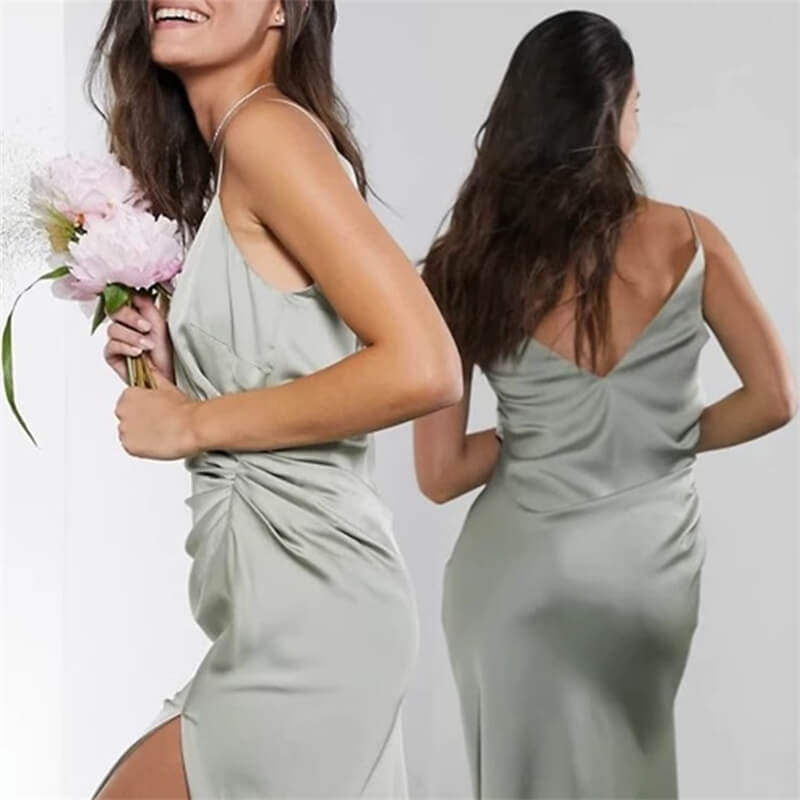
Section 1: The Elegance of Satin Bridesmaid Dresses
Satin, with its lustrous sheen and smooth texture, has long been a symbol of elegance and sophistication in bridal fashion. This luxurious fabric, known for its glossy finish and rich drape, offers a level of formality and grandeur that can elevate any wedding aesthetic. In this section, we’ll explore the unique attributes of satin as a choice for bridesmaid dresses, its advantages, potential drawbacks, and how it can be integrated into various wedding themes and styles.
The Richness of Satin Fabric
Satin, characterized by its tightly woven fibers, creates a surface that beautifully reflects light, adding a sense of depth and opulence to the bridesmaid dresses. This reflective quality ensures that the dresses look stunning in different lighting conditions, making them especially appealing for evening or indoor weddings where lighting plays a key role in photography.
Advantages of Choosing Satin
- Photogenic Qualities: Satin’s sheen makes it particularly photogenic, ensuring that bridesmaids look radiant in wedding photos. Its ability to catch light adds a dynamic element to photographs, highlighting the elegance of the bridal party.
- Formality and Sophistication: Satin is often associated with more formal weddings due to its luxurious appearance. It lends a sense of sophistication that is hard to match, making it a perfect choice for traditional or black-tie events.
- Versatility in Styles: Satin works well with a wide range of dress styles, from classic A-line to modern fit-and-flare. Its structure allows for beautiful draping and can be tailored to flatter different body types.
Challenges with Satin Dresses
While satin is undeniably elegant, it does present some challenges:
- Comfort Considerations: Satin can be heavier than other fabrics, which might be less comfortable for outdoor or summer weddings. Its less breathable nature requires consideration, especially in warmer climates.
- Maintenance Concerns: Satin can show sweat and wrinkles easily. This means bridesmaids may need to be cautious about their activities and how they sit or move during the day.
- Selective Suitability: Not all body types are flattered by satin, as it tends to cling and does not hide imperfections well. This factor needs careful consideration to ensure all bridesmaids feel confident and beautiful.
Incorporating Satin into Different Wedding Themes
Satin’s versatility allows it to be incorporated into various wedding themes:
- Classic and Traditional Weddings: For a timeless look, satin dresses in more conservative cuts and colors like deep reds, navy, or even black can add a touch of class.
- Modern and Chic Weddings: Satin dresses in bold colors or with contemporary cuts (like off-the-shoulder or high-low hemlines) can add a modern twist.
- Romantic and Vintage Weddings: Soft pastel-colored satin dresses with lace detailing can evoke a sense of vintage romance.
Final Thoughts
When considering satin for bridesmaid dresses, it’s important to weigh its elegance and beauty against its practical limitations. By selecting the right style and color, and by considering the comfort of the bridesmaids, satin can offer a stunning and sophisticated option for wedding attire. It’s a fabric that speaks of celebration, making it a worthy choice for the special role that bridesmaids play in the wedding.
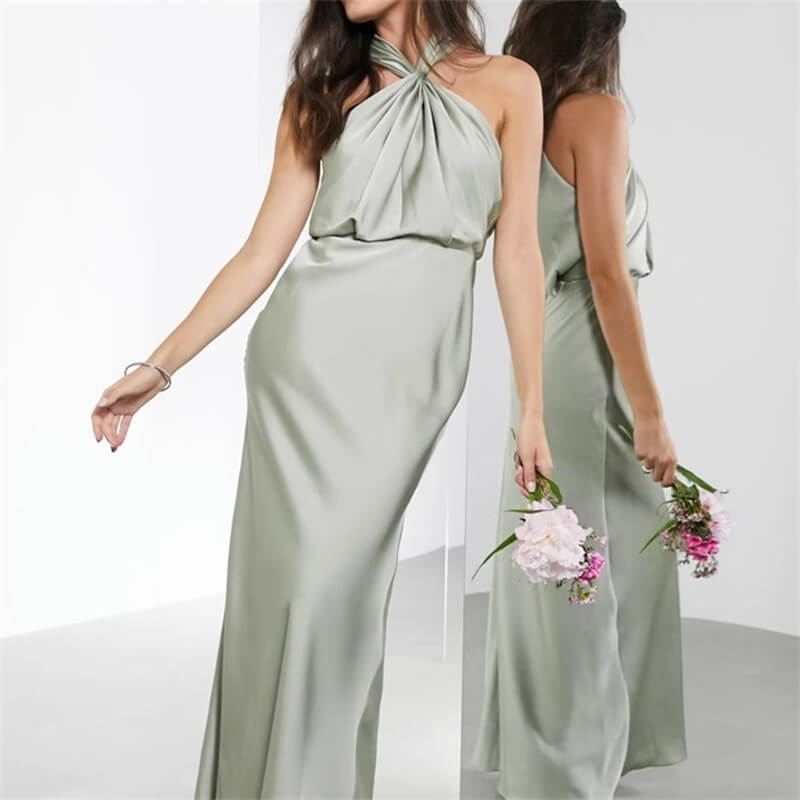
Section 2: The Charm of Chiffon Bridesmaid Dresses
Chiffon, a fabric known for its fairy-tale essence, brings an ethereal charm to bridesmaid dresses that few materials can match. This section delves into the allure of chiffon, highlighting its characteristics, advantages, and considerations to help brides decide if it’s the right choice for their wedding party.
The Nature of Chiffon
- Light and Flowy: Chiffon is celebrated for its lightness and fluid drape. Made from silk, cotton, synthetic fibers, or a blend, it is a sheer fabric with a slightly rough feel to the touch.
- Ethereal Appearance: Its transparent quality allows for layering, which creates a delicate, floating appearance. This makes it perfect for romantic, whimsical wedding themes.
- Versatility in Design: Chiffon can be used in various dress designs, from simple A-line cuts to more elaborate, layered gowns. Its versatility also extends to different necklines and sleeve options, accommodating a wide range of styles and preferences.
Advantages of Choosing Chiffon
- Flattering for All: Chiffon’s flowy nature makes it incredibly flattering for bridesmaids of all body types. It skims the body without clinging, offering a graceful silhouette.
- Comfort and Ease: For weddings in warmer climates or outdoor venues, chiffon’s breathability is a significant advantage. It keeps bridesmaids comfortable throughout the event.
- Movement and Grace: The fluidity of chiffon adds dynamism to the bridesmaids’ movements, enhancing their presence and interaction during the ceremony and in photographs.
- Color and Light: Chiffon’s semi-transparent quality allows it to interact beautifully with light, offering a stunning play of colors and shades that can be particularly impactful in outdoor settings.
Considerations When Opting for Chiffon
- Sheerness and Lining: Since chiffon is sheer, proper lining is crucial to ensure that dresses are appropriate and comfortable. This may require additional tailoring or design considerations.
- Care and Maintenance: Chiffon can be delicate and may snag or tear easily. It requires careful handling and storage, both before and after the wedding.
- Less Formal Feel: For more formal or traditional weddings, chiffon might seem too casual. Its ethereal quality, while beautiful, might not align with the desired level of formality.
- Weather and Venue Suitability: While perfect for spring and summer weddings, chiffon might not be the best choice for colder weather or extremely formal indoor settings.
In summary, chiffon bridesmaid dresses offer a blend of elegance, comfort, and adaptability. They are particularly suited to outdoor, spring, or summer weddings where their light, airy quality can be fully appreciated. When considering chiffon, it’s important to think about the overall theme of the wedding, the comfort and preferences of the bridesmaids, and the practical aspects of the fabric. With the right design and care, chiffon bridesmaid dresses can add a magical, dream-like quality to your wedding, making it a truly memorable event.
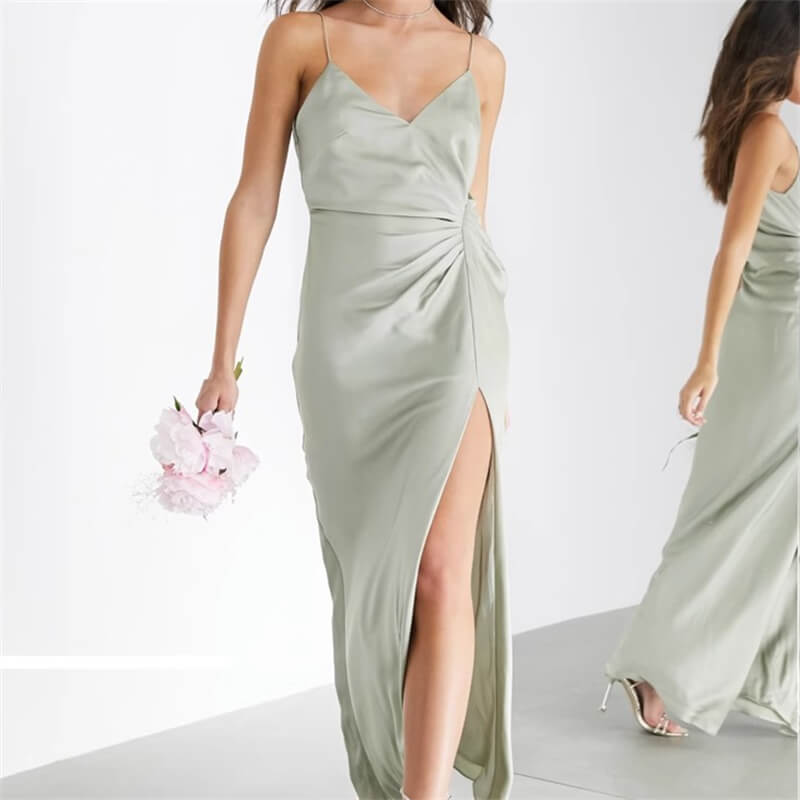
Graceful Spaghetti Satin Bridesmaid Dress
Crafted from luxurious satin, the dress features delicate spaghetti straps that create a feminine and sophisticated neckline.
The bodice, tailored to perfection, flatters the figure, while the flowing skirt adds a touch of romance and movement. Its sleek design is both timeless and contemporary, making it an ideal choice for various wedding themes and settings.
Section 3: Factors to Consider When Choosing Fabric
When selecting the perfect fabric for bridesmaid dresses, several key factors need careful consideration. These factors can significantly influence not only the look and feel of the dresses but also the comfort and satisfaction of the bridesmaids. Below, we explore these crucial aspects to help you make an informed decision between satin and chiffon for your wedding party.
1. Season and Venue of the Wedding
- Climate Adaptability: Satin, with its heavier weight, is more suitable for cooler climates or indoor settings. It can provide warmth in a fall or winter wedding. Chiffon, being light and airy, is ideal for warmer weather or outdoor venues, such as beach or garden weddings.
- Venue Aesthetics: The fabric should complement the venue’s aesthetics. Satin works well in grand, luxurious settings like ballrooms or historic mansions, while chiffon fits beautifully in more natural, laid-back environments.
2. Wedding Theme and Style
- Formality Level: Satin lends itself to a more formal, sophisticated look, aligning well with black-tie or evening weddings. Chiffon offers a more casual, bohemian vibe, suitable for rustic, vintage, or whimsical themes.
- Consistency in Theme: The fabric should reflect the overall theme of the wedding. For a glamorous, opulent theme, satin is a go-to choice. For a softer, more romantic theme, chiffon is more appropriate.
3. Comfort and Preferences of the Bridesmaids
- Body Types and Comfort: Chiffon’s forgiving nature suits a wide range of body types and is generally more comfortable, especially in warmer temperatures. Satin, while elegant, may not be as accommodating to diverse body shapes and can be less comfortable in hot weather.
- Individual Preferences: Consider the personal style and comfort preferences of your bridesmaids. Some may prefer the luxurious feel of satin, while others might favor the lightweight comfort of chiffon.
4. Color and Texture Compatibility
- Color Representation: Satin and chiffon can display colors differently due to their distinct textures. Satin, with its sheen, can make colors appear more vibrant, while chiffon offers a softer, more muted look.
- Texture and Look: The texture of the fabric adds to the visual appeal. The smooth, shiny surface of satin provides a sleek look, whereas chiffon’s sheer and floaty nature offers a delicate, graceful appearance.
5. Budget Considerations
- Cost Differences: Generally, satin can be more expensive due to its rich look and feel. Chiffon is often more affordable, making it a practical choice for weddings on a tighter budget.
- Alterations and Tailoring Costs: Consider the cost of alterations, which can vary depending on the fabric. Satin may require more precise tailoring, potentially increasing costs.
6. Durability and Maintenance
- Wrinkle Factor: Satin can wrinkle easily and may require careful handling and storage. Chiffon is more resistant to wrinkles, making it easier to manage on the day of the wedding.
- Care and Longevity: Consider the care needed for each fabric. Satin may need professional cleaning, while chiffon is often easier to maintain and can be more durable in the long run.
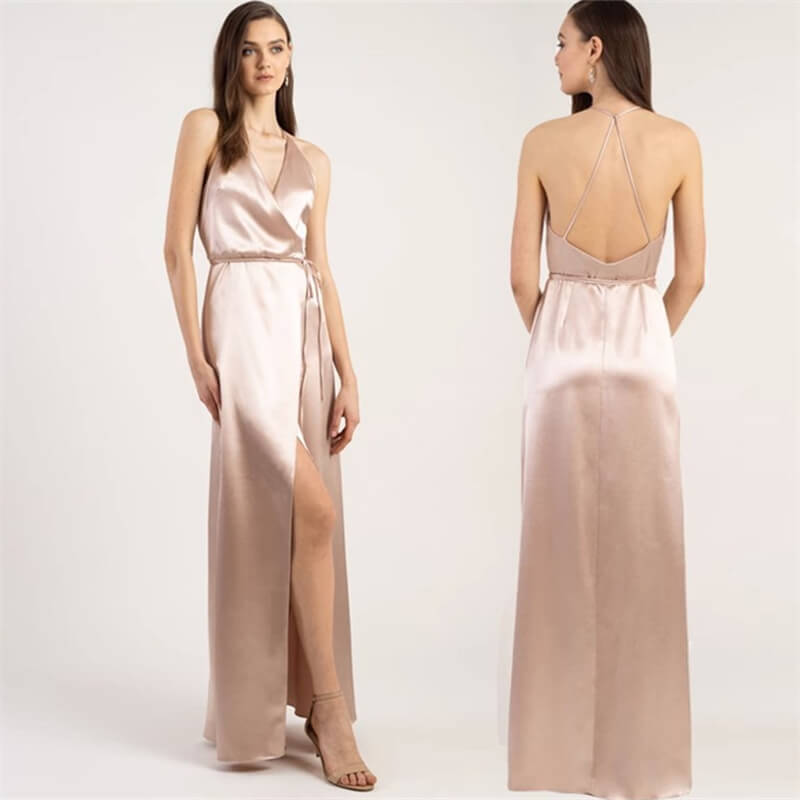
Section 4: Coordinating with the Wedding Gown
- Importance of complementing the bride’s gown.
- Matching the formality and style of the wedding dress.
- Consideration of color schemes and overall wedding palette.
Section 5: Accessories and Alterations
Selecting the right accessories and understanding the nuances of alterations are essential steps in finalizing the bridesmaid look, whether you choose satin or chiffon. These elements play a pivotal role in not only enhancing the dress but also ensuring that each bridesmaid feels comfortable and confident. This section delves into the details of accessorizing and tailoring bridesmaid dresses made from satin and chiffon, guiding you through choices that will complement the fabric, the dress style, and the overall theme of the wedding.
1. Accessories for Satin Bridesmaid Dresses
- Jewelry Selection: Satin’s luxurious sheen pairs well with both bold and understated jewelry. For a formal look, consider elegant pieces like pearl necklaces or diamond earrings. For a more contemporary style, geometric shapes or colored gemstones can add a unique touch.
- Shoes: High-heeled pumps or strappy sandals in metallic or nude tones complement the elegance of satin. For winter weddings, closed-toe heels or even stylish ankle boots can be considered.
- Hair Accessories: Depending on the dress style, satin dresses can be paired with sleek hairpins, beaded headbands, or even a classic tiara for a regal look. Keep the hairstyle elegant to match the fabric’s formality.
2. Accessories for Chiffon Bridesmaid Dresses
- Jewelry Selection: With chiffon’s airy and romantic feel, opt for delicate jewelry like thin chain necklaces, dainty bracelets, or drop earrings. Floral motifs or pastel-colored stones can echo the whimsical nature of the fabric.
- Shoes: Flat sandals, ballet flats, or low heels are great choices for chiffon dresses, especially for outdoor or beach weddings. They offer comfort without compromising style.
- Hair Accessories: Soft curls or relaxed updos go well with chiffon dresses. Consider floral crowns, ribbon ties, or simple clips for a bohemian or garden-inspired look.
3. Alterations for the Perfect Fit
- Timing and Professional Tailoring: Encourage your bridesmaids to get their dresses altered at least a month before the wedding. This allows enough time for adjustments. Always use a professional tailor, especially for fabrics like satin and chiffon that require careful handling.
- Satin Dress Alterations: Satin can be tricky to alter due to its tendency to fray and show needle marks. Emphasize the importance of minimal alterations and precision in tailoring. Adjustments in the bust, waist, and length are common.
- Chiffon Dress Alterations: Chiffon’s delicate nature means alterations should be minimal to maintain the integrity of the fabric. Layered chiffon dresses might need adjustments in the hemline and straps, ensuring a comfortable and secure fit without altering the flow of the dress.
4. Final Touches
- Coordinating with the Wedding Palette: Choose accessories that complement the wedding colors. This could mean matching the metal of the jewelry with other wedding elements or choosing shoes that tie in with the bridesmaids’ bouquet colors.
- Comfort Considerations: Remember that your bridesmaids will be wearing these dresses for an extended period. Comfort is key, so choose accessories that won’t be burdensome or uncomfortable as the day progresses.
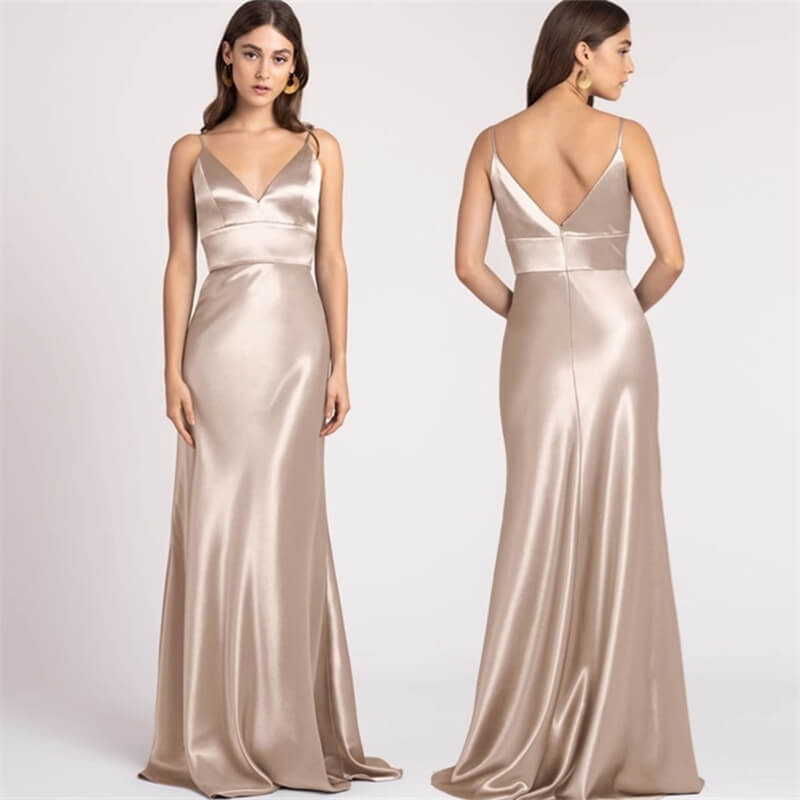
Conclusion
The choice between satin and chiffon for bridesmaid dresses is more than just a fabric decision. It’s a reflection of the wedding’s aesthetic, the comfort and confidence of the bridesmaids, and the harmonious coordination with the bride’s gown. As we’ve explored in this article, both satin and chiffon offer unique benefits and challenges, making them suitable for different types of weddings and bridesmaid preferences.
Satin, with its luxurious sheen and elegant drape, brings a level of sophistication and formality to a wedding. It is a fabric that commands attention and exudes a classic, timeless charm. For evening weddings or those with a more formal setting, satin is an excellent choice. However, it’s crucial to remember the potential downsides of satin, such as its tendency to wrinkle and its less forgiving nature on various body types. These factors need to be weighed carefully, especially when considering the comfort and confidence of each bridesmaid.
On the other hand, chiffon is the epitome of romance and grace. Its lightweight, flowing nature makes it ideal for outdoor, beach, or summer weddings. Chiffon gowns can make bridesmaids feel effortlessly elegant, and the fabric’s forgiving nature suits a wide range of body types. However, its sheer nature and less structured form might not align with all wedding themes, especially more formal ones.
When choosing between these two beautiful fabrics, several factors should be considered. The season and location of the wedding are crucial; a beach wedding in the heat of summer calls for different attire than a formal evening affair in a grand ballroom. The overall theme and style of the wedding also play a significant role. A fairy-tale princess wedding might lean towards the ethereal quality of chiffon, while a classic, luxurious wedding might call for the richness of satin.
The bridesmaids’ comfort and preferences are paramount. These are the women who play a significant role in the bride’s life, and their comfort and confidence on the day are just as important as their appearance. The choice of fabric should not only flatter their body types but also resonate with their styles and comfort levels.
Coordinating with the bride’s gown is another aspect that cannot be overlooked. The bridesmaids’ dresses should complement the bridal gown, not compete with it. Whether the bride opts for a lavish satin dress or a delicate chiffon gown will heavily influence the appropriate choice for the bridesmaids.
Finally, remember that accessories, alterations, and the right color choice can significantly enhance the overall look, regardless of the fabric chosen. The right earrings, necklace, or bouquet can tie the bridesmaids’ looks to the wedding theme, and professional alterations can ensure that each dress fits perfectly.
In conclusion, whether you choose satin or chiffon for your bridesmaids, the key is to balance aesthetics with practical considerations. Reflect on the overall vision of your wedding, consider the needs and preferences of your closest friends, and remember that the goal is to create a harmonious, beautiful day where everyone, especially the bridesmaids, feels special and valued. Your wedding is a celebration of love and unity, and the joy and comfort of your bridesmaids in their dresses will only enhance this beautiful occasion.



